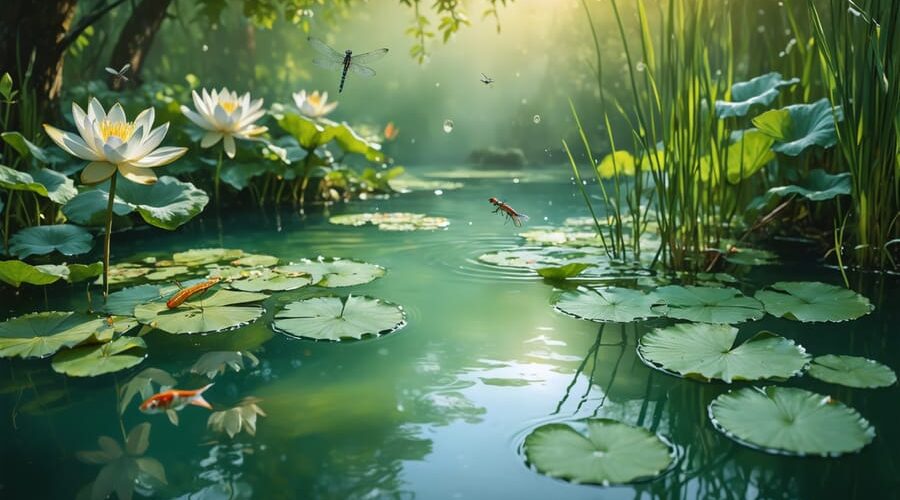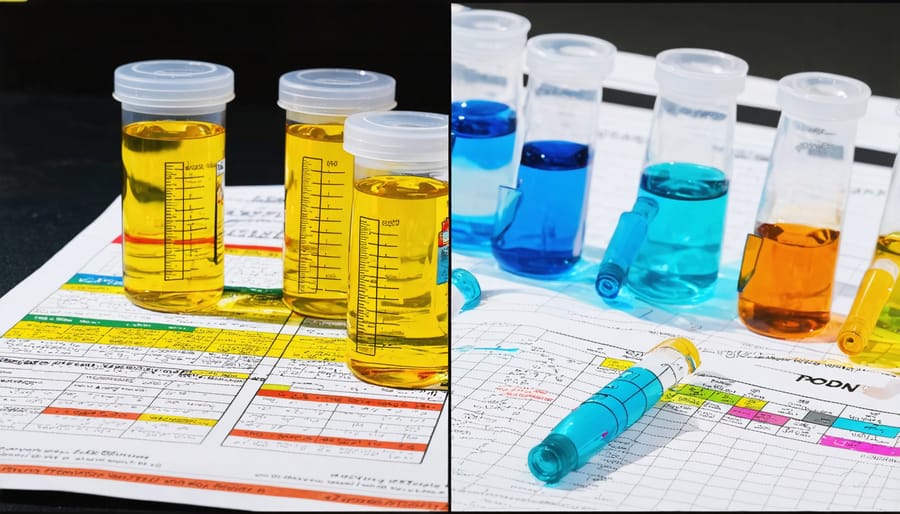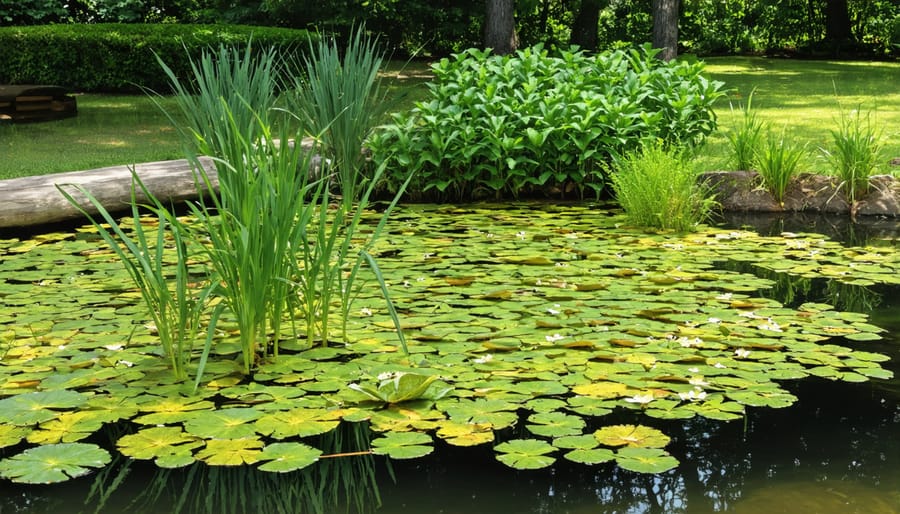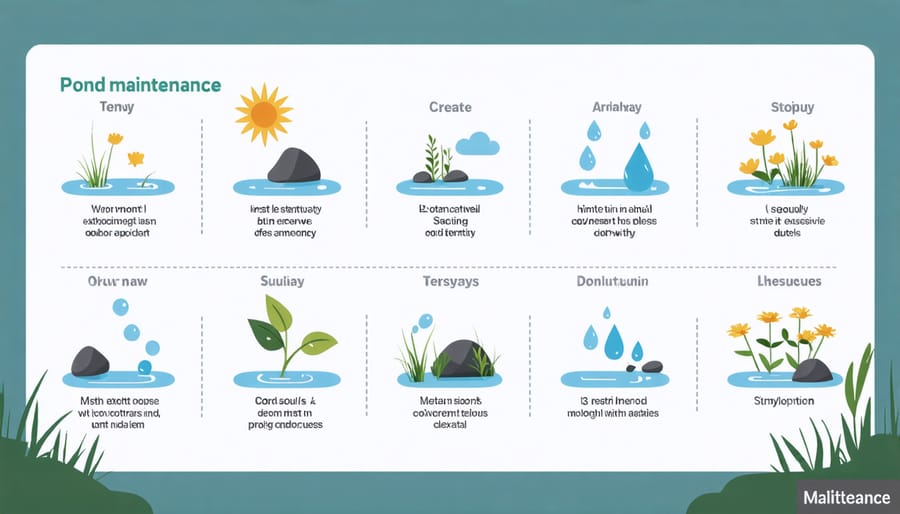
Keep Your Pond Thriving Year-Round with These Natural Maintenance Secrets
Managing a healthy pond requires a delicate balance of natural elements working in harmony. Like a well-orchestrated symphony, each component – from water quality to plant life, fish populations to beneficial bacteria – plays a crucial role in creating a thriving aquatic ecosystem. Whether you’re maintaining a backyard water garden or overseeing a larger recreational pond, understanding the fundamentals of pond management can transform a stagnant water body into a vibrant, self-sustaining habitat.
Regular monitoring of water parameters, including pH, dissolved oxygen, and nutrient levels, forms the foundation of effective pond management. These indicators serve as early warning signs, allowing you to address potential problems before they escalate into costly issues. Successful pond management also embraces natural solutions, such as incorporating native aquatic plants that filter excess nutrients and provide essential habitat for beneficial organisms.
Consider your pond as a living, breathing ecosystem rather than just a body of water. This holistic approach to management ensures long-term stability and reduces the need for chemical interventions. By following proven maintenance strategies and understanding the biological relationships within your pond, you can create a balanced environment that practically maintains itself while providing years of enjoyment and ecological benefits.
Creating the Perfect Water Balance
Natural Filtration Systems
A healthy pond relies heavily on natural filtration methods to maintain clear water and support aquatic life. The key players in this process are beneficial bacteria, which break down waste and convert harmful compounds into harmless ones. These microscopic helpers thrive in areas with lots of surface area, like on rocks, plants, and specially designed filter media.
Plants play a crucial role in natural filtration too. Water lilies, cattails, and submerged plants like hornwort act as living filters, absorbing excess nutrients that would otherwise feed algae. Try to cover about 60% of your pond’s surface with various plants for optimal results.
Creating a dedicated bog filter area can supercharge your pond’s natural filtering capabilities. This shallow section, filled with gravel and marsh plants, acts like nature’s kidney as water flows through it. The gravel provides a home for beneficial bacteria, while the plants pull out nutrients and add oxygen to the water.
Don’t forget about bottom-dwelling cleaners! Adding a few freshwater mussels or snails can help keep the pond floor clean, while fish like koi naturally stir up sediment, preventing stagnant areas. This living ecosystem works together, each member playing its part in maintaining crystal-clear water.
Remember to be patient – natural filtration systems take time to establish, but once they’re up and running, they’re incredibly effective and low-maintenance.

Water Testing and Adjustment
Regular water testing is essential for maintaining a healthy pond ecosystem. Understanding and managing proper water chemistry helps prevent issues before they become serious problems.
Test your pond water weekly using a reliable testing kit that measures pH, ammonia, nitrites, and nitrates. Aim for a pH between 6.8 and 7.8, which suits most pond life. If you notice the pH drifting, natural solutions like adding limestone for raising pH or peat moss for lowering it work gently and safely.
Keep ammonia and nitrite levels as close to zero as possible. High readings indicate an overloaded filtration system or excess waste. Combat this by reducing feeding, removing debris, and adding beneficial bacteria. For nitrates, aim for levels below 20 ppm. Water plants help naturally reduce nitrates by consuming them as nutrients.
Dissolved oxygen is crucial for fish health. Signs of low oxygen include fish gasping at the surface, especially in early morning. Add oxygen through fountains, waterfalls, or air pumps. During hot summers, running these features at night helps maintain stable oxygen levels when plants aren’t photosynthesizing.
Monitor water temperature too – sudden changes stress fish. A pond thermometer helps track these fluctuations, letting you adjust feeding and maintenance schedules accordingly. Remember, healthy water parameters mean less work and happier pond inhabitants in the long run.
Plant Management for Pond Health
Choosing the Right Plants
Selecting the right plants for your pond is crucial for creating a balanced ecosystem. Start with plants for different water depths, beginning at the pond’s edge and working your way in. For the marginal zone (0-6 inches deep), consider native species like marsh marigold, rushes, and iris, which help stabilize the bank and provide natural filtration.
In the shallow water zone (6-12 inches), water plantain and arrowhead make excellent choices, offering cover for fish and helping to reduce algae growth. For deeper waters (12-24 inches), opt for submerged oxygenating plants like hornwort and water milfoil, which are essential for maintaining water quality.
Don’t forget floating plants like water lilies, which not only add beauty but also provide shade and shelter for pond life. When choosing, aim for a mix of about 60% submerged plants, 30% marginal plants, and 10% floating plants.
Native species are always the best choice as they’re adapted to your local climate and support local wildlife. Avoid invasive species that can quickly take over your pond and disrupt the ecosystem. Remember to plant in spring or early summer when water temperatures are warming up, giving your plants the best chance to establish themselves.

Seasonal Plant Maintenance
Spring kicks off your pond’s maintenance calendar with essential pruning and dividing of aquatic plants. Remove dead foliage and trim back invasive growth to prevent overcrowding. As water temperatures rise, fertilize your plants with specialized aquatic fertilizer tablets.
Summer requires regular deadheading of flowering plants like water lilies to encourage continuous blooming. Monitor marginal plants along the pond’s edge, keeping them tidy and preventing them from spreading too aggressively. Watch for yellowing leaves, which might indicate nutrient deficiencies.
Fall is the time to cut back dying foliage and remove fallen leaves before they sink and decompose. Tropical plants should be moved indoors before the first frost, while hardy varieties can be trimmed and left in place. Lower hardy plants to deeper water to protect them from freezing.
Winter maintenance is minimal but crucial. Remove any remaining dead plant material and protect sensitive species with floating covers or netting. For plants left outdoors, avoid breaking ice around them as this can damage their crown. If you have indoor tropical plants, maintain them under grow lights and reduce fertilization until spring.
Remember to always use clean, sharp tools when pruning to prevent disease transmission between plants. Keep your pruning schedule consistent to maintain your pond’s aesthetic appeal and ecological balance throughout the year.
Natural Algae Control Methods
Prevention Strategies
Preventing pond problems is much easier than fixing them later. Start by incorporating plenty of aquatic plants, which naturally compete with algae for nutrients. Aim to cover about 60-70% of your pond’s surface with a mix of floating and submerged plants. Water lilies are particularly effective at providing shade and reducing algae growth.
Creating a balanced ecosystem is key to long-term success. Install a proper filtration system and maintain good water circulation with fountains or waterfalls. These features not only add visual appeal but also increase oxygen levels, which helps beneficial bacteria thrive. Consider adding natural algae control solutions like barley straw or beneficial bacteria supplements.
Regular maintenance plays a crucial role in prevention. Remove fallen leaves and debris before they can decompose and feed algae growth. Test water parameters monthly and adjust as needed. Remember to avoid overfeeding fish, as excess food breaks down into nutrients that fuel algae growth. By following these preventive measures, you’ll spend less time troubleshooting and more time enjoying your pond.
Treatment Solutions
Natural solutions offer effective and eco-friendly ways to control algae without harsh chemicals. One of the most reliable methods is adding beneficial aquatic plants like water lilies and floating plants, which compete with algae for nutrients and provide shade. Barley straw is another fantastic organic option – when placed in mesh bags and floated in the pond, it releases compounds that naturally inhibit algae growth.
Creating a balanced ecosystem is key. Add a mix of submerged plants like hornwort and surface plants like duckweed to maintain oxygen levels and reduce nutrients available for algae. Installing an aerator or fountain helps circulate water and increase oxygen levels, making it harder for algae to thrive.
Regular maintenance plays a crucial role too. Remove debris and dead plant material promptly, and consider adding beneficial bacteria that naturally break down organic matter. For smaller ponds, you can manually remove string algae using a pond rake or brush. UV clarifiers offer another chemical-free solution, using ultraviolet light to clear green water without harming fish or beneficial organisms.
Remember, prevention is always better than cure – maintaining proper filtration and avoiding overfeeding fish will help keep algae at bay naturally.
Wildlife Management and Enhancement
Attracting Beneficial Species
Creating a welcoming environment for beneficial wildlife can significantly improve your pond’s health and natural balance. Dragonflies, for instance, are excellent mosquito controllers, while frogs and toads help manage insect populations. To attract these helpful creatures, incorporate various native aquatic plants around your pond’s edges and in shallow areas.
Consider adding flat rocks or logs near the water’s edge to create basking spots for frogs and beneficial insects. Installing a shallow beach area with gradually sloping sides makes it easier for wildlife to access the water and provides safe zones for amphibians to lay eggs.
Bird species like swallows and martins can help control flying insects. Attract them by placing birdhouses near your pond or installing natural perches. Beneficial insects such as ladybugs and praying mantises can be encouraged by planting native flowering plants around your pond’s perimeter.
Remember to maintain some brush piles or natural debris near your pond, as these provide essential shelter for various beneficial species. However, ensure these features don’t compromise your pond’s maintenance or aesthetics. By creating these wildlife-friendly elements, you’ll develop a more balanced ecosystem that largely manages itself while providing endless entertainment through wildlife observation.
Managing Unwanted Visitors
While ponds naturally attract wildlife, some visitors can become problematic for your pond’s ecosystem. Fortunately, there are several humane ways to manage unwanted guests without causing harm. For deterring herons and other fish-eating birds, try installing a floating decoy predator or setting up a motion-activated sprinkler system. These harmless deterrents will startle birds without hurting them.
To keep raccoons at bay, consider placing chicken wire or netting just below the water’s surface around the pond’s edges. This creates an invisible barrier that makes it difficult for them to reach in and catch fish, while maintaining your pond’s natural appearance. Solar-powered LED lights around the pond can also discourage nocturnal visitors.
For algae-eating ducks that might overwhelm your pond, try using floating barrier balls or decorative floating elements that make landing difficult. Plant tall grasses or shrubs around parts of your pond to reduce easy access points while enhancing your landscape’s beauty.
Remember that some wildlife visitors actually benefit your pond’s ecosystem. Frogs and dragonflies, for instance, help control mosquito populations naturally. The key is finding the right balance between welcoming beneficial creatures while gently discouraging those that might cause damage to your pond’s inhabitants or structure.

Seasonal Maintenance Calendar
A well-maintained pond requires different care throughout the year. Let’s break down essential tasks by season to keep your pond healthy and thriving.
Spring (March-May):
– Remove debris and dead plant material
– Clean filters and check pump functionality
– Test water quality as temperatures rise
– Add beneficial bacteria to jumpstart the ecosystem
– Begin feeding fish gradually as water warms
– Trim and divide aquatic plants
Summer (June-August):
– Monitor water levels and top off as needed
– Control algae growth naturally with shade plants
– Clean skimmer boxes weekly
– Feed fish regularly during peak activity
– Maintain plants and remove spent blooms
– Check water quality bi-weekly
Fall (September-November):
– Net the pond to catch falling leaves
– Trim dying plant material
– Reduce fish feeding as temperatures drop
– Clean filters thoroughly
– Remove tropical plants or prepare winter protection
– Install a de-icer if needed
Winter (December-February):
– Keep a small hole in ice for gas exchange
– Remove snow from ice to allow light penetration
– Avoid breaking ice surface directly
– Monitor de-icer functionality
– Stop feeding fish
– Perform equipment maintenance
Monthly Year-Round:
– Check pump operation
– Remove debris from skimmers
– Observe fish behavior
– Test water parameters
– Inspect liner edges
– Monitor plant health
Remember that timing may vary based on your climate zone, so adjust these tasks according to local weather patterns and seasonal changes.
Maintaining a healthy pond is a rewarding journey that benefits both you and the environment. By following sustainable practices like regular water testing, natural filtration methods, and proper plant management, you’ll create a thriving ecosystem that largely maintains itself. Remember that a balanced pond requires less intervention over time, saving you both effort and resources.
The key to success lies in prevention rather than correction. Regular monitoring of water quality, maintaining proper plant coverage, and supporting beneficial wildlife will help avoid common problems before they arise. Using natural solutions like beneficial bacteria and aquatic plants not only keeps your pond healthy but also creates a more resilient ecosystem.
Your pond can become a beautiful, self-sustaining feature of your landscape when managed correctly. The practices we’ve discussed not only ensure crystal-clear water and healthy fish but also contribute to local biodiversity and environmental health. By taking a patient, nature-first approach, you’ll enjoy your pond for years to come while providing a valuable habitat for local wildlife and creating a peaceful oasis in your backyard.
